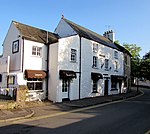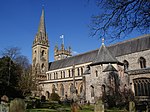11 High Street, Llandaff

11 High Street, also known as 'Mrs Pratchett's' sweet shop, is a two-storey residential building in Llandaff, Cardiff, Wales. It was Catherine Morgan's Confectioner and Tobacconist shop in the early 20th century. It was converted into a Chinese restaurant known as The Great Wall around 2009. It is currently in use as a self-catering holiday let. The building is not a listed building, unlike others in High Street, such as St Andrew, St Cross, 6 High Street and 19 High Street. The building is best known for where The Great Mouse Plot of 1923 occurred, where Roald Dahl and four other school-boys played a prank on the sweet shop owner, by putting a dead mouse in a gobstopper jar. At the time of the prank the shop was owned by Catherine Morgan, although in his book Boy: Tales of Childhood her pseudonym is Mrs Pratchett, and the shop was 'Mrs Pratchett's sweet shop'. The sweet shop inspired Dahl's stories such as Charlie and the Chocolate Factory, The Twits and Matilda. In September 2009 a blue plaque was unveiled by his widow, Felicity, and his son Theo, on one of his favourite sweet shops.
Excerpt from the Wikipedia article 11 High Street, Llandaff (License: CC BY-SA 3.0, Authors, Images).11 High Street, Llandaff
High Street, Cardiff Llandaff
Geographical coordinates (GPS) Address Nearby Places Show on map
Geographical coordinates (GPS)
| Latitude | Longitude |
|---|---|
| N 51.49403 ° | E -3.21873 ° |
Address
High Street 11
CF5 2DY Cardiff, Llandaff
Wales, United Kingdom
Open on Google Maps











